For some time now, sous vide cooking has become the go-to for people looking for something different. Of all the foods to try and cook, a sous vide steak is one of the most popular.
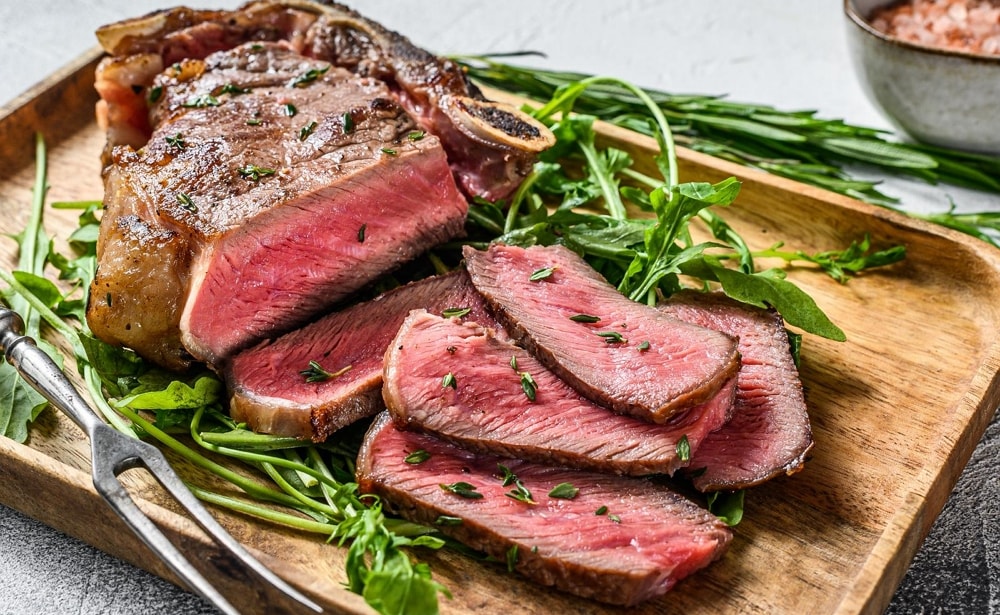
Sous vide cooking can remove a lot of the potential risks and mistakes that can ruin other forms of cooking. When done right, many believe that sous vide steak can taste as good – if not better – than the expensive stuff you buy from a steakhouse.
However, cooking a steak sous vide is not easy, so it is important to learn about what you are doing. Whether you intend to have sous vide t-bone steak, sous vide beef tenderloin or sous vide sirloin steak or go down the route of some flank steak sous vide style, this guide will help you get started from getting the correct sous vide steak temp to learning how long to sous vide steak.
Table of contents
Why Sous Vide Steak?
You might wish to go down the route of using a sous vide steak cooking process for several reasons. Just some of the reasons to consider learning how to sous vide steak include:
Precision
Sous vide offers unparalleled control over steak preparation, allowing you to cook your steak to the precise level of doneness you desire. Gone are the days of guesswork to achieve that perfect medium-rare. No more poking with thermometers, no more cutting and peeking, no need for the old finger test—perfect results, every single time.
Flexibility
Sous vide steak cooking also gives you more time to prep other things. Sear the steak before serving, and you can get an evenly cooked steak! Another big benefit of using sous vide steak is that you have a much longer window between perfectly cooked steak and overcooked. Serve when you are ready.
With Typhur Sous Vide Station Schedule mode, you can cook your food ahead of time so it’s ready when you get home.
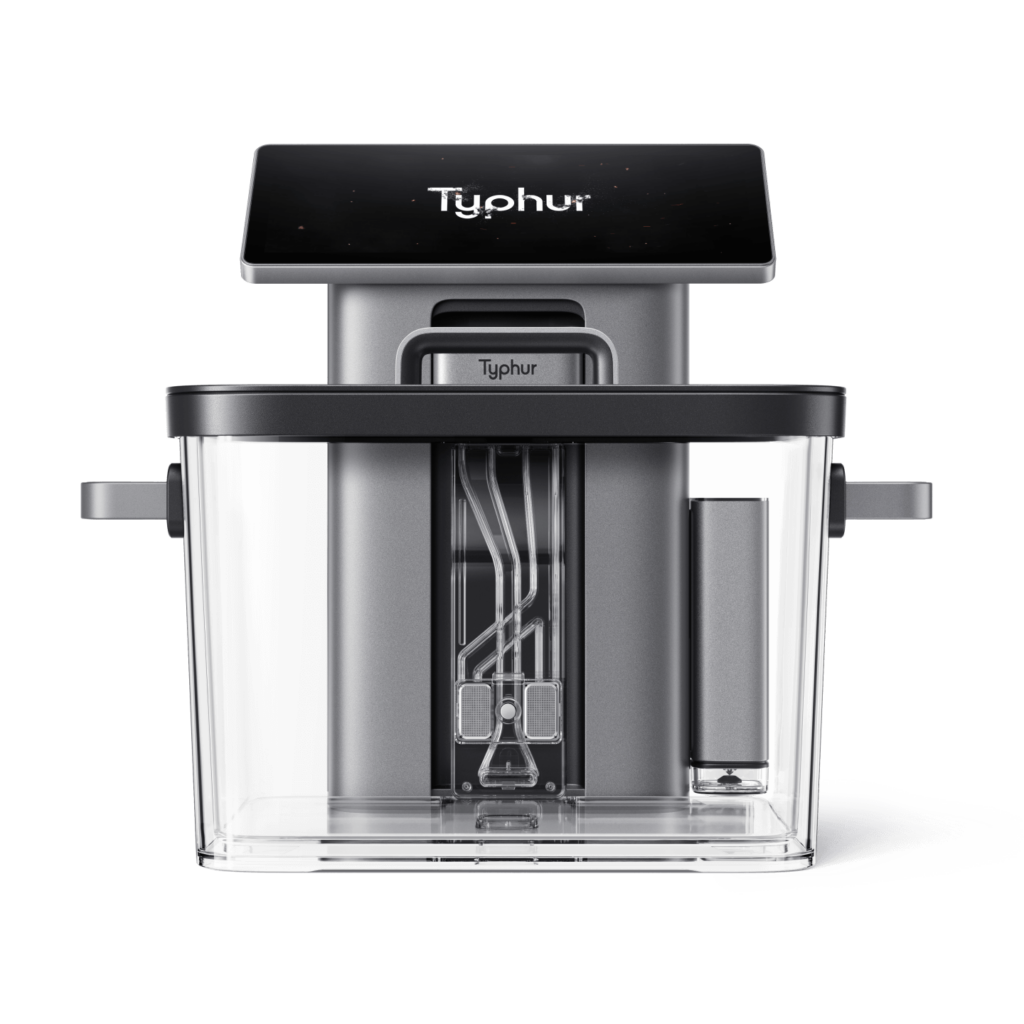
All-in-One Sous Vide Machine
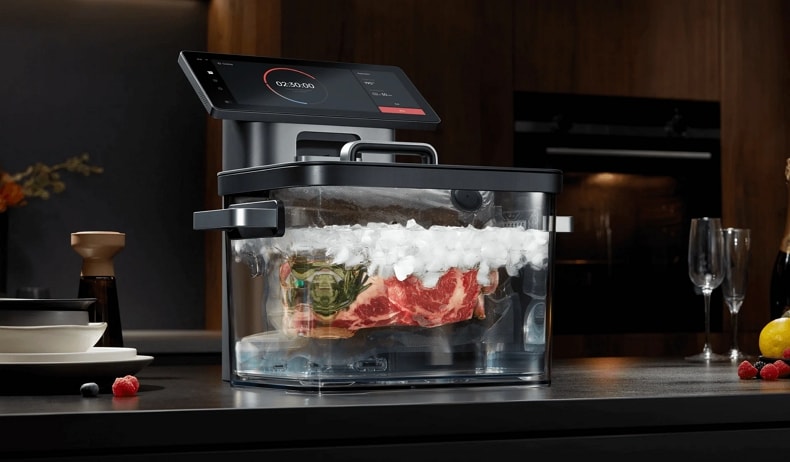
Evenly Cooked
Through traditional high-heat cooking methods, a temperature gradient forms within the meat. While the center of the steak might achieve medium-rare doneness, as you move toward the exterior, the steak becomes progressively more well-done. Sous vide eliminates this problem. The entire cut of meat cooks evenly, ensuring a consistent texture and taste from edge to edge. You can even sous vide frozen steak and still get that consistent medium-rare finish throughout the meat.

As Kenji said, “Sous vide cooking allows you to cook better than the best steakhouse.” So long as you invest in high-quality sous vide setup, like this Typhur Sous Vide Station, you should be likely to get almost perfect results every single time – all without the time pressure that cooking steak often brings.
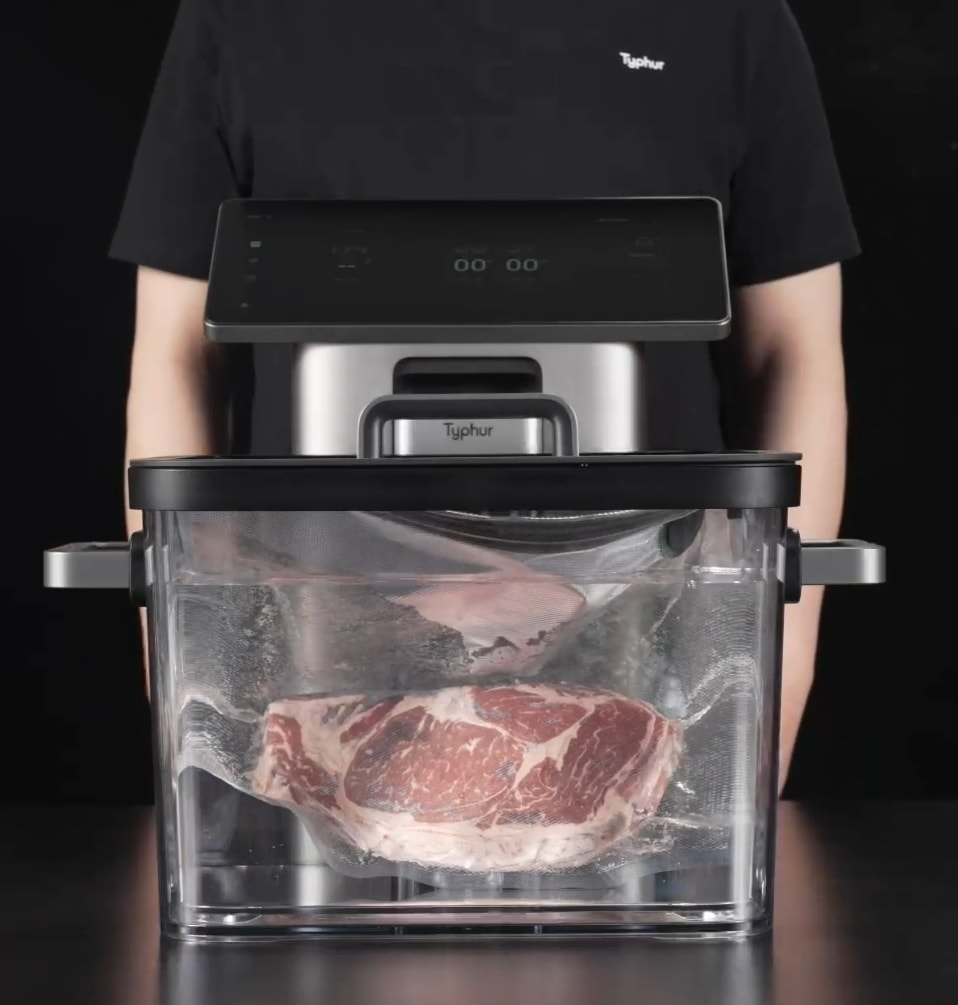
The Typhur Sous Vide Station: Highlight Features
- The World’s 1st All-in-One Design
- Simplified Sous Vide Process
- 12.3-Inch Touchscreen with Built-In Recipes
- Schedule Function
Cook Steak Sous Vide
If you want to learn how to cook a sous vide steak, use this guide below to give you a good idea of what you should do. This should allow for the best possible results in your sous vide steak experience.
1. Two-Phase Process
So, the first thing to note is that a sous vide steak is a two-step process. The first part of the process involves putting your steak into a plastic bag and then cooking it via your sous vide station. This will bring it to your desired temperature (see our sous vide steak temperature guide below).
The second step of the process will then mean searing the steak in a grill or skillet. This will help you get the right color, tone, and flavor you like in your steak meat. This will also help soften the fat that can stay quite tough when cooking sous vide steak.
2. Temperature And Timing
The first thing to note when cooking any sous vide steak is that the initial temperature you cook will differ depending on several things. For one, the kind of steak that you are cooking matters. A sous vide sirloin steak will vary from a sous vide flank steak. Learning the differences will help you to get the perfect sous vide steak temperature every time.
Temperature and timing changes for every kind of steak. For example, a ‘butcher’s cut’ such as flap or skirt steak will have different cooking times to a ‘tender cut’ of steak like a ribeye or porterhouse steak. We will try to break down everything below so you know roughly how long to sous vide steak.
Timing is very important when it comes to cooking a sous vide steak. Many believe you could cook a sous vide steak at a low temperature and have it sit there cooking until you are ready. If only life were so simple!
Even at a low temperature, your steaks are still cooking away. Chemical reactions still occur even at lower heat. While sous vide steak can be booked for even as long as 24 hours without harming the juiciness, it can impact the chewiness and flavor of the steak. Try to stick to our sous vide steak temperature chart below to understand better what you are doing.
3. Ideal Thickness For Sous Vide Steak
So, one thing to note here is that the thickness of your sous vide steak will be very important. A steak that is too thin will overcook before it is ready, while a steak that is too thick can be very hard to get the right overall balance from interior and exterior heat and rawness.
Generally, the idea is to use a thick steak – but not too thick. Something in the region of 1.5” to 2” should be fine for most steak lovers. If it sounds too much for you to eat on your own, turn that 2” steak into two 1” steaks by slicing it in half when you are finished. This makes it easier to be more economical, too, turning one large piece of steak meat into food for two instead of having excessive leftovers.
4. Sous Vide Cooked Steak Vs Traditionally Cooked Steak
There are some important differences to be aware of when cooking steak normally versus cooking sous vide steak. With a normal cooking method, you have a very limited amount of time to get the steak right – a minute too short and your steak is almost raw; a minute too long and your steak is like rubber!
With sous vide steak, you can have hours to cook your steak exactly as you want. This can be great for cooking for many people or for making sure you have ample time to prepare the sides that you will need for this.
Temperature And Timing Charts For Sous Vide Steak
Generally, there is a set limit for how long to sous vide steak and the temperatures you should allow the steak to reach. This is most easily done if you break down the steak style you intend to eat into various temperatures and times. Use the charts below to help make sure that your sous vide steak cooks to the right level every time.
Strip, Ribeye, Porterhouse/T-Bone
Some of the most common forms of steak that people eat are the more ‘marbled’ forms of steak like strip, ribeye, and porterhouse steaks. Generally, it would be best if you looked to aim for the following timings when cooking strip, ribeye, or porterhouse/T-bone steaks:
| Steak Doneness | Target Temperature | Length Of Time |
| Very Rare-Rare | 120°F (49°C) to 128°F (53°C) | 1h to 2h 30m |
| Medium-Rare | 129°F (54°C) to 134°F (57°C) | 1h to 4h |
| Medium | 135°F (57°C) to 144°F (62°C) | 1h to 4h |
| Medium-Well | 145°F (63°C) to 155°F (68°C) | 1h to 3h 30m |
| Well-Done | 156°F (69°C) | 1h to 3h |
If you want to go down the route of a proper Porterhouse steak, then we recommend that you look at the following:
| Steak Doneness | Target Temperature | Length Of Time |
| Very Rare-Rare | 120°F (49°C) to 128°F (53°C) | 45m to 2h 30m |
| Medium-Rare | 129°F (54°C) to 134°F (57°C) | 45m to 4h |
| Medium | 135°F (57°C) to 144°F (62°C) | 45m to 2h 30m |
| Medium-Well | 145°F (63°C) to 155°F (68°C) | 45m to 3h 30m |
| Well-Done | 156°F (69°C) | 1h to 3h |
As you can see, the times only change slightly if you go for a Porterhouse/T-bone steak – you can usually get away with a shorter cooking time if you prefer. As a rule of thumb, you should ensure that any steak cooked to around 130°F (57°C) is not cooked for more than 2 hours and 30 minutes.
Tenderloin Steaks
If you prefer a tenderloin steak, it is very easy – too easy – to ruin it. Tenderloin steaks tend to be easily overcooked, thus drying them out and removing much of their flavor. If you are cooking a steak, make sure that if you cook under the 130°F (57°C) range, you do not cook the steak for any longer than 2h 30m, as above.
| Steak Doneness | Target Temperature | Length Of Time |
| Very Rare-Rare | 120°F (49°C) to 128°F (53°C) | 45m to 2h 30m |
| Medium-Rare | 129°F (54°C) to 134°F (57°C) | 45m to 4h |
| Medium | 135°F (57°C) to 144°F (62°C) | 45m to 2h 30m |
| Medium-Well | 145°F (63°C) to 155°F (68°C) | 45m to 3h 30m |
| Well-Done | 156°F (69°C) | 1h to 3h |
Sticking to the above sous vide steak temp will likely wind up with a delightful piece of meat. Just find and follow a sous vide steak recipe that you think sounds nice, and then follow the times above, and you should be left with a beautiful piece of meat that is cooked to the exact level that you are looking for.
How To Cook A Steak Sous Vide
If you are going down the route of cooking a sous vide steak, then you should follow this quick and easy guide to make sure you get as close to the ideal finish as you were hoping for:
- First, you should set up your sous vide station and be ready. Pre-heat the sous vide station to the final temperature you want, per the charts above.
- Allow the temperature to reach the level you need before considering putting the steak in there.
- Now, start seasoning the steak meat that you are using. The best seasoning is some basic salt and pepper. Once seasoned, put the steak into a vacuum-sealed bag.
- If you are cooking steak to eat later on down the line (i.e., to freeze it), then do not season it now, as you can do this later on with a frozen steak.
- Seal the bag you will be using for your steak using a vacuum sealer, or close the bag over if you are using Ziploc bags.
- Start cooking your steak by dropping it into the sous vide water bath. The steak should sink to the bottom; the bag is not fully sealed if it floats.
- Begin the cooking process by following the sous vide steak temperature chart we have given you above. Please pay close attention to the steak as it cooks.
- Once the steak reaches the temperature level that you are looking for, remove it from the bag and then place the steak on some paper towels atop a plate.
- Begin patting down the sous vide steak so that it is as dry as it can be on both sides of the meat. If you have not seasoned the steak, do so now.
Finishing The Steaks Off
- Get a stainless steel (or cast iron if you prefer) skillet and pre-heat this. Please take it to the highest heat that you have. Add something like 1 tbsp of vegetable oil to the skillet.
- Once the oil is smoking hot, start searing the steak by adding it in using a pair of tongs. Include anything you wish to add, like rosemary and thyme, garlic cloves, etc.
- Allow the sous vide steak to sizzle for around 30 seconds, then flip the steak so it can cook on the other side. Flip it every 15 to 30 seconds from now on.
- Before the steak finishes, add a small amount of butter – around 30 seconds before you finish. This should create the ideal end taste that you are looking for.
- Before you finish up, do not forget about the edges of your sous vide steak. With a pair of tongs, give the steak around 45 seconds on each of the edges of the steak.
- The steak should now be finished as you were hoping for. Add the steak to a wire rack and pour fats and juices from the skillet/pan over the steaks.
- Serve immediately and enjoy – you have just, hopefully, created some perfect-tasting sous vide steaks!
FAQs About Sous Vide Steak
Now that you have finished your sous vide steaks to perfection (hopefully), it is time to try them out for yourself. Before you do that, read these most frequently asked questions about this kind of steak cooking to understand the process better.
1. What Are The Downsides To Cooking Steak Sous Vide Compared To Traditional Cooking Methods?
There are some downsides to going down the sous vide steak route – though not many. Our most common complaint about sous vide steak cooking is that it adds more time to the cooking process, though it does require less attention to cook right.
Also, searing is never as efficient as searing a normally cooked piece of steak. This gives you a thinner level of sear, which some find unpalatable. Lastly, cooking sous vide steaks requires you to get Sous Vide Station to cook them in. However, if you already own a sous vide station, that does not matter!
2. Can I Sous Vide Frozen Steak?
You sure can! You can use a sous vide steak frozen or fresh. Always look into the process a little further, such as thawing time, but most of the time you can take a frozen steak from the freezer and begin your sous vide steak recipe.
3. Does Sous Vide Steak Need To Rest?
No, you do not need to allow a sous vide steak to rest after cooking. Resting is required in order to enable the whole steak to reach the same temperature level. Sous vide steaks cook from edge to edge, and the level of rest they need will take place as you set the steak up to be served. No need for resting here!
4. Should You Put Butter In Sous Vide Steak?
It depends – if you put butter on a sous vide steak, do it right at the end, just before you take it out of the skillet. However, you do not need to use butter for that finishing touch – it is something we recommend trying, but it is not for everyone.
5. Do High-End Steakhouses Use Sous Vide?
Many do today, yes. While sous vide steak cooking was once frowned upon by the pros, this is not so much the case anymore. As such, you should have no problem getting a sous vide steak if you go to a restaurant or high-end steakhouse. Some restaurants still insist on the ‘old fashioned’ way, but not every steakhouse will. Many now use more modern methods, including sous vide.


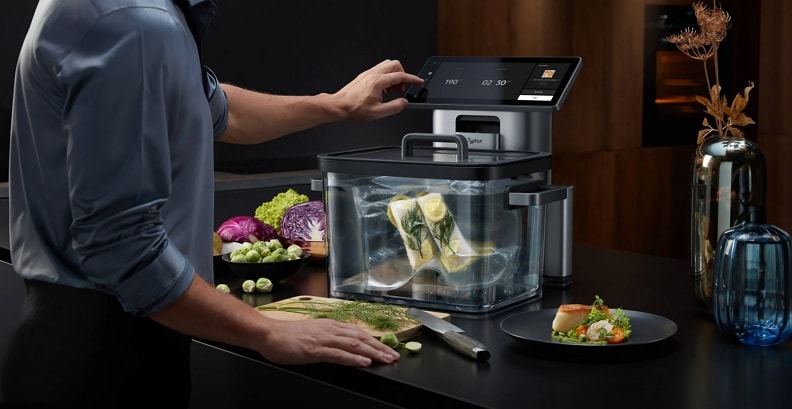

So helpful. Thank you.
HI Steve,
I need your guidance on cooking ribeye steaks. I’ll be cooking steaks for 6 people and each person has their own preference of their steak cook. 2 people wants their steaks well done, 1 person wants medium and 3 people want medium rare. Please help me on how to cook the steaks on 3 different doneness. Can I sous vide the steak a day ahead? Can I seal the steak in separate bag for each temperature? I appreciate all your help on this. Thanks in advance. Jeannie
Hi Jeannie, to get different doneness levels for the ribeyes, I recommend sous vide them all to medium rare, then finish them off to desired doneness by searing. Be sure to check the internal temperature with a meat thermometer to ensure they’re cooked just right.